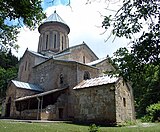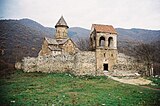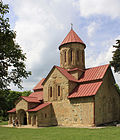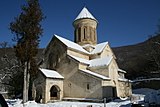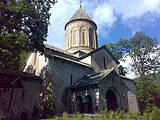User:Kober/sandbox
History of Georgia
[edit]Tbilisi
[edit]Anton I
[edit]Rodovid ka:ანტონ I qim [1] lib.ge drevo Joselian DM Lang [2] Portrait (source) [3] [4]
4) H.H. The Most Brilliant Prince Taimurazi (s/o Queen Eleni). Appointed as the first Metropolitan of Kutais, Patriarch-Catholicos of Georgia as Antoni I from 1745. Converted to Roman Catholicism ad expelled from Georgia 1755, emigrated to Russia, where Catherine the Great appointed him as Archbishop of Vladimir and Hierapolis in 1764. He d. unm. at Tiflis, 29 February 1788 o.s. (or 19 March 1790) (bur. Mtzkheta Monastery).
Nevertheless, there were several reasons why Erekle might prove amenable to the idea of a Russian alliance. Erekle's cousin, the Catholicos-Patriarch of Eastern Georgia, Antoni I, was a trusted adviser and counsellor to the king. Antoni had spent several years in Russia, had from time to time represented Erekle in St. Petersburg, and was a strong proponent of the ‘Russian orientation’ at the royal court. Gvosdev 32 Finally, Erekle and his cousin Patriarch Antoni were possessed of a grand vision for the restoration of Georgian greatness. With Russian military help, it would be possible not only to secure existing Georgian territories from attack, but to liberate other Georgian and Orthodox Christian territories under direct Persian or Ottoman control. Gvosdev 33
1771–1773 embassy to Russia --- Gvosdev 42
The Church played an important role in this process. On 20 September 1783, the day that the Treaty was formally and publicly announced to the people of Tbilisi, the Catholicos-Patriarch Antoni, Metropolitan Germanos of Tbilisi, and another archbishop conducted a service to celebrate the signing of the pact. Gvosdev 60
Rayfield 122
In the intellectual life of the nation the Georgian Orthodox Church continued to play the leading part. It was fortunate in having as its head through most of Erekle's reign a catholicos-patriarch of the caliber of Antoni I. Antoni had occupied for some years an archbishopric in Russia, and was a man of broad vision and sympathies. His Georgian grammar is a landmark in the study of the language. He was versed in Russian and in the classics. In 1762, he translated into Georgian, F. C. Baumeister's Elementa philosophiae recentioris under the title of A\hali filosofia, and introduced into Georgia the philosophical system of Christian Wolf. He also made a rendering of the Categories of Aristotle. Last Years, p. 202. Ibid, 81, 173, 187, 202, 288.
Samtskhe
[edit]ka:დედისიმედი ka:ოქროს ციხე ka:მესხური დავითნის ქრონიკა qim Dedisimedi (qim) Manuchar II (qim) Kaikhosro II (qim)
Geschichte Georgiens Altunkal'a Hakimesi Rodovid Javaxisvili [5] [6] [7] [8] [9] [10] [11] Dedesmit Dede Semid
The new atabag, Qvarqvare IV, was a puppet of his imperious mother, Dedisimedi, who had her main rival, the nobleman Varaz Shalikashvili, murdered. An uprising and an attempt on Qvarqvare IV followed. All through 1576-7 civil war raged through eastern Samtskhe, destroying towns such as Tmogvi. Qvarqvare appealed to the shah, but Tahmasp died in 1576... Akhalkalaki was occupied; Qvarqavare IV and his mother Dedisimedi surrendered. Rayfield 175–176
Achara and, since with the new turn Waraza's son, Kokola, had got in before them in the Turkish favour, the young Atabegi Qwarqware V and his brother Manuchar appealed despairingly to Tahmasp. In 1576 events moved to a crisis of confusion. In Samtzkhe Kokola Shalikashvili and the young Jaqelis were loosing a desperate civil carnage. Every little baron in the upland country took a hand for one side or the other, and the peasants paid in a most dreadful spoliation. In that war the last strength of the marchland principality — for long so turbulent and free — was altogether wasted. In Kazvin when Tahmasp died, the Shalikashvili dowager, working with Yese, Alexander's brother,1 had made Shah a weakly, high-strung boy, Haydar. But the Georgian adventurers in Kazvin, nominal Muslims whom the easy Shi'ah men about the court regarded with no animosity, were glowered upon by the strong Sunni faction, who on the death of Shah Tahmasp began to raise their heads... WED ALLEN
- 1268–1285 Sargis I ... son of prince Bek'a Jaqeli; atabeg of Meschia from 1268
- 1285–1306 Bek'a I ... son of Sargis I
- 1306–1334 Sargis II ... son of Bek'a I
- 1334–1361 Qvarqvare II ... son of Sargis II
- 1361–1391 Bek'a II ... son of Qvarqvare II
- 1391–1444 Ioane ... son of Bek'a II
- 1444–1451 Aġbuġa ... son of Ioane
- 1451–1466 Qvarqvare III ... son of Bek'a II; sovereign prince from 1463
- 1466–1475 Baadur ... son of Qvarqvare III
- 1475–1487 Manuč'ar I ... son of Qvarqvare III
- 1487–1500 Qvarqvare IV ... son of Aġbuġa
- 1500–1502 K'aixosro I ... son of Qvarqvare IV
- 1502–1515 Mzečabuk the Great ... son of Qvarqvare IV
- 1515–1535 Qvarqvare V ... son of K'aixosro I
- 1535–1545 (to Imeret'i)
- 1545–1573 K'aixosro II ... son of Qvarqvare V
- 1573–1581 Qvarqvare VI ... son of K'aixosro II
- 1581–1614 Manuč'ar II (Muởụafā Paša) ... son of K'aixosro II
- 1614–1624 Manuč'ar III ... son of Manuč'ar II
- 1625–1635 Bek'a III (Ởafar Paša) ... son of K'aixosro II
- 1635–1647 Yūsuf I ... son of Bek'a III; paša of Meschia
- 1647–1659 Rostom ... son of Yūsuf I
- 1659–1680 Aslan I ... son of Rostom
- 1680–1690 Yūsuf II ... son of Aslan I
- 1690–1701 Salīm ... son of Aslan I
- 1701–1705 Isằāq ... son of Yūsuf II; deposed
- 1705–1708 Aslan II ... son of Salīm; deposed
- 1708–1716 Isằāq ... restored; deposed
- 1716–1718 Aslan II ... restored
- 1718–1737 Isằāq ... restored; abdicated
- 1737–1744 Yūsuf III ... son of Isằāq
- 1744–1750 Isằāq ... restored
Exonyms
[edit]- Abasheti = Aksum, Ethiopia (Rapp, The Sasanian World, pp. 292, 296–7)
Kutaisi
[edit]CUTATISIUM (Κουτατίσιον, Procop. B. G. 4.13, 14), a small town in Colchis, on the river Phasis, now Kchitais or Kutais. It was identified with the mythical Cytae or Cytaea, said to have been the birthplace of Medea (Steph. B. sub voce Pin. 4.12. s. 26), whence the adjectives Cytaeaeus and Cytaeus, used in reference to Medea and Colchis (Propert. 1.24; V. Fl. 6.693). Scylax, on the other hand, states that Mala, on the same river, was entitled to that honour.[12]
Polis barbaron in the Black Sea area in archaic and classical periods Timeline
- c. 1454 – The Imeretian Bagratid prince Bagrat acquires Kutaisi and its region in possession.[1]
- c. 1463 – Prince Bagrat loses Kutaisi to King George VIII of Georgia as suggested by a royal charter issued in that city.[1]
- 1463 – Victorious at Chikhori, Prince Bagrat regains Kutaisi and is crowned as King of Imereti.[1]
- 1474 – The Venetian diplomat Giosafat Barbaro visits Kutaisi on his way to Persia, describing it in his report as "a small town called Cotochis, where, on a hill, there is a castle built entirely of stone, containing a church which has the appearance of being very ancient".[2]
- 1509 – An Ottoman raiding party, reportedly under the command of the then-prince Selim, sacks Kutaisi during the absence of King Alexander II of Imereti at a campaign in Gori, in Kartli.[3]
- 1871
- 15 May – An Orthodox cathedral of St. Alexander Nevsky is consecrated in the center of Kutaisi;[4] demolished in 1924.
- 1921
- 10 March – The 11th Red Army occupies Kutaisi.
- 18 March – An agreement between the RSFSR and the DRG concerning cessation of hostilities.[13]
- 1976 – A bomb blast rocks the Kutaisi Central Garden, with no reported casualties, on 14 April. The convict, Vladimer Zhvania, a lone anti-Soviet activist, also blamed for earlier explosions in Sukhumi and Tbilisi, would be tried and executed in 1977.[5]
- 2004
- 5 March – Police carries out a large-scale special operation in Kutaisi, arresting 15 "thieves-in-law" and, also, Bondo Shalikiani, an influential businessman and member of the Parliament, allegedly linked to the crime world.[6]
- 14 June – In one of Georgia's largest prison breaks, 41 inmates escape from the Geguti prison near Kutaisi, after killing a prison guard.[6]
- 2009
- 25 February – Kutaisi adopts its first modern flag and coat of arms.[7]
- 4 August – During the reconstruction works at Kutaisi's 11th-century Bagrati Cathedral, archaeologists discover an unusually rich tomb of a young woman, probably dated to the 8th century.[8]
- 19 December – A woman and her 11-year-old daughter are killed and several people injured in an explosion to demolish a World War II memorial monument at the site of a planned parliament headquarters in Kutaisi. Several employees of a demolition company would later be arrested on charges of violation of safety standards.[9]
- 2011
- 31 March – Police says it has prevented terrorist attacks in Kutaisi, arresting three suspected plotters from breakaway Abkhazia, allegedly operating on instructions from a Russian military officer.[10]
- 1 July – The Parliament of Georgia passes a constitutional amendment envisaging relocating the next Parliament, to be elected in 2012, from Tbilisi to Kutaisi.[11]
- 22 July – Tamta Liparteliani, 23-year-old Georgian activist of the Kutaisi branch of the Young Socialists of Georgia, is killed in a terrorist attack at a summer camp on the Norwegian island of Utøya, the only foreigner of 69 fatalities.[12]
- 2012
- 26 May – Kutaisi hosts the country's main Independence Day military parade. It is the first time the event is not held in the capital city of Tbilisi.[13]
- 14 September – The reconstructed 11th-century Bagrati Cathedral, a UNESCO World Heritage site, is opened after a series of controversies over possible authenticity infringement.[14][15]
- 21 October – The newly elected Parliament holds its inaugural session, marking the legislature's relocation from Tbilisi to Kutaisi.[16]
- 2014
- 15 June – The self-governing city of Kutaisi holds its first-ever direct mayoral election.
Caucasian War
[edit]- Кавказская война. Том 1. От древнейших времен до Ермолова
- Кавказская война. Том 2. Ермоловское время
- Кавказская война. Том 3. Персидская война 1826-1828 гг.
- Кавказская война. Том 4. Турецкая война 1828-1829гг.
- Кавказская война. Том 5. Время Паскевича, или Бунт Чечни
- Потто В. А. Кавказская война в отдельных очерках, эпизодах, легендах и биографиях: В 5 т. — СПб.: Тип. Е. Евдокимова, 1887-1889.
- Mikaberidze 2011
- Кавказские войны
- Дубровин Н. Ф. История войны и владычества русских на Кавказе: В 6 т. — СПб.: Тип. Департамента уделов, 1871-1888.
- Исторический очерк кавказских войн от их начала до присоединения Грузии
- Материалы для описания русско-турецкой войны 1877-1878 гг. на Кавказско-Малоазиатском театре
- Хронология русской военной истории
Theatre
[edit]Monuments
[edit]Heritage in the occupied Tskhinvali region [17]
1.ერედვის წმინდა ელიას ეკლესია.
2.ერედვის წმინდა გიორგის ეკლესია.
3.კულბითის ღვთისმშობლის ეკლესია.
4.სოფელი ძარწემი-წმინდა გიორგის ეკლესია.
5.კეხვი- ღვთიმშობლის ეკლესია.
6.არმაზის ეკლესია,რომელიც თარიღდება 864 წლით.
7.წირქოლის ეკლესია(VIII-IX) საუკუნეები.
8.ერედვის ბაზილიკა (906) წელი.
9.ხეითის საბაწმინდის ეკლესია (X) საუკუნე.
10.დოდოთის ცხრაკარას ეკლესია (X-XI) საუკუნეები.
11.ნიქოზის გუმბათიანი ტაძარი (X-XI) საუკუნეები.
12.იკორთის გუმბათიანი ტაძარი (1172) წელი. / იკორთის ციხე
13.თიღვის გუმბათიანი ტაძარი (XII) საუკუნეები. [18] [19] [20] [21]
14.ხოფას მონასტერი (XIII) საუკუნეები.
15.ყანჩაეთის კაბენი (IX-XIII) საუკუნეები.
16.ლარგვისი (XIV-XVIII) საუკუნეები. [22] [23] [24] [25]
Kakheti 1812
[edit]List of Georgian saints
[edit]Cathedrals of Tamar's era
[edit]Family trees
[edit]| Adarnase Prince of Erusheti-Artani, coheir of Klarjeti-Javakheti | |||||||||||||||||||||||||||||||||||||
| Ashot I (†826/830) | Latavr m. Juansher of Kakheti | ||||||||||||||||||||||||||||||||||||
| Adarnase (830-c.870) | Bagrat I (830-876) | Guaram Mampali (†882) | Daughter m. Theodosius II of Abasgia | ||||||||||||||||||||||||||||||||||
Misc.
[edit]| Year | Georgians | Abkhaz | Russians | Armenians | Greeks |
|---|---|---|---|---|---|
| 1886 | 34,114 (50.3%) | 28,320 (42%) | 971 (1.4%) | 1,037 (1.5%) | 2,056 (3%) |
| 1914 | 44.8% | 27.3% | (?) | 11% | 10% |
| 1926 Census | 67,494 (33.5%) | 55,918 (27.8%) | 12,558 (6.2%) | 25,677 (12.7%) | 14,045 (7%) |
| 1959 Census | 158,221 (39.1%) | 61,193 (15%) | 86,715 (21.4%) | 64,425 (15.9%) | 9,101 (2.2%) |
| 1970 Census | 199,595 (40.9%) | 77,276 (15.9%) | 92,889 (19%) | 74,860 (15.3%) | 18,114 (3.7%) |
| 1979 Census | 213,322 (43.8%) | 83,097 (17.1%) | 79,730 (16.4%) | 73,350 (15.1%) | 18,642 (3.8%) |
| 1989 Census | 239,872 (45.7%) | 93,267 (17.7%) | 74,914 (14.2%) | 76,541 (14.5%) | 14,664 (2.7%) |
Cornell, Svante E. (2001), Small Nations and Great Powers: A Study of Ethnopolitical Conflict in the Caucasus, p. 156. Routledge (UK), ISBN 0700711627.
{{Georgia-geo-stub}}
{{Georgia-stub}}
{{Georgia-geo-stub}}
{{Georgia-bio-stub}}
{{WPMILHIST}}
{{WPMA}}
{{PD-GE-exempt}}
{{Georgia-struct-stub}}
http://en.wiki.x.io/wiki/Template:Multiple_image
References
[edit]- ^ a b c Toumanoff 1949–51, p. 192.
- ^ Barbaro, Giosofat (2009). Travels to Tana and Persia, and A Narrative of Italian Travels in Persia in the 15th and 16th Centuries. Cambridge University Press. p. 119. ISBN 1108010814.
- ^ Rayfield 2012, p. 164.
- ^ Nikolai, Aleksandr (1873). Отчет по Главному управлению наместника Кавказского за первое десятилетие управления Кавказским и Закавказским краем е. и. в. вел. кн. Михаилом Николаевичем. 6 дек. 1862 - 6 дек. 1872 г. Tiflis. p. 93.
{{cite book}}: CS1 maint: location missing publisher (link) - ^ Nahaylo, Bohdan; Swoboda, Victor (1990). Soviet Disunion: A History of the Nationalities Problem in the USSR. Simon and Schuster. p. 190. ISBN 0029224012.
- ^ a b "Timeline – 2004". Civil Georgia. 3 January 2005. Retrieved 27 January 2015.
- ^ "ქუთაისის გერბი და დროშა [Coat of arms and flag of Kutaisi]". Council of Heraldry (in Georgian). Retrieved 27 January 2015.
- ^ "Bagrati Cathedral New Relic". The Newsletter of Kutaisi–Newport International Association. December 2009. Retrieved 27 January 2015.
- ^ "Two More Arrested over Memorial's Deadly Blast". Civil Georgia. 22 December 2009. Retrieved 27 January 2015.
- ^ "Police Say Foiled Terrorist Attacks in Kutaisi". Civil Georgia. 31 March 2011. Retrieved 27 January 2015.
- ^ "Relocation of Parliament to Kutaisi Passed with Final Reading". Civil Georgia. 1 July 2011. Retrieved 27 January 2015.
- ^ "Georgian Girl Confirmed Dead in Norway Island Massacre". Civil Georgia. 28 July 2011. Retrieved 27 January 2015.
- ^ "Independence Day Military Parade in Kutaisi". Civil Georgia. 27 May 2012. Retrieved 27 January 2015.
- ^ "Reconstructed Bagrati Cathedral opens in Kutaisi". Rustavi 2. 14 September 2012. Retrieved 27 January 2015.
- ^ "Opposition, Ruling Party Leaders Gather to Mark Opening of Rebuilt Cathedral". Civil Georgia. 16 September 2012. Retrieved 27 January 2015.
- ^ "Newly Elected Parliament Convened". Civil Georgia. 21 October 2012. Retrieved 27 January 2015.


